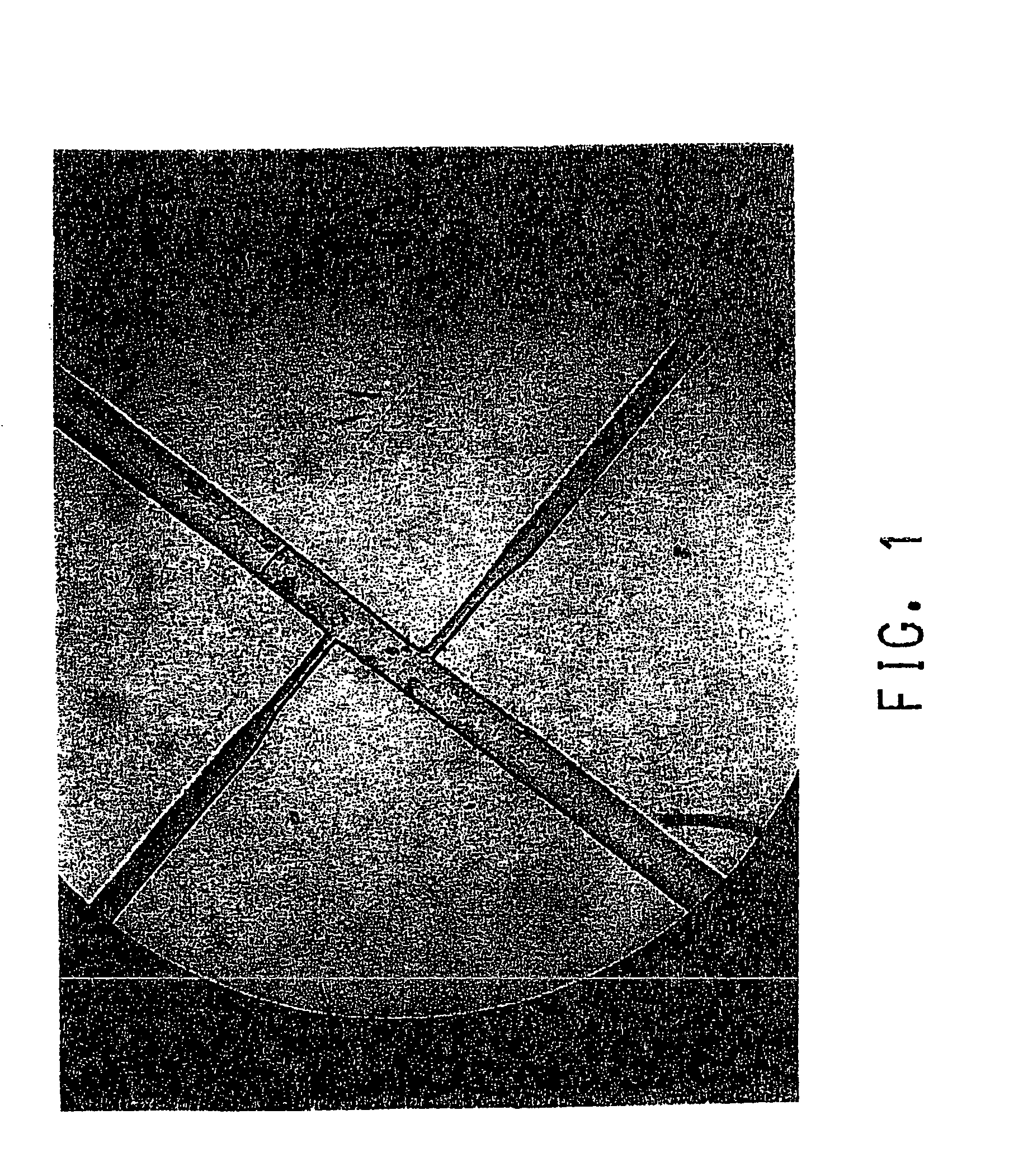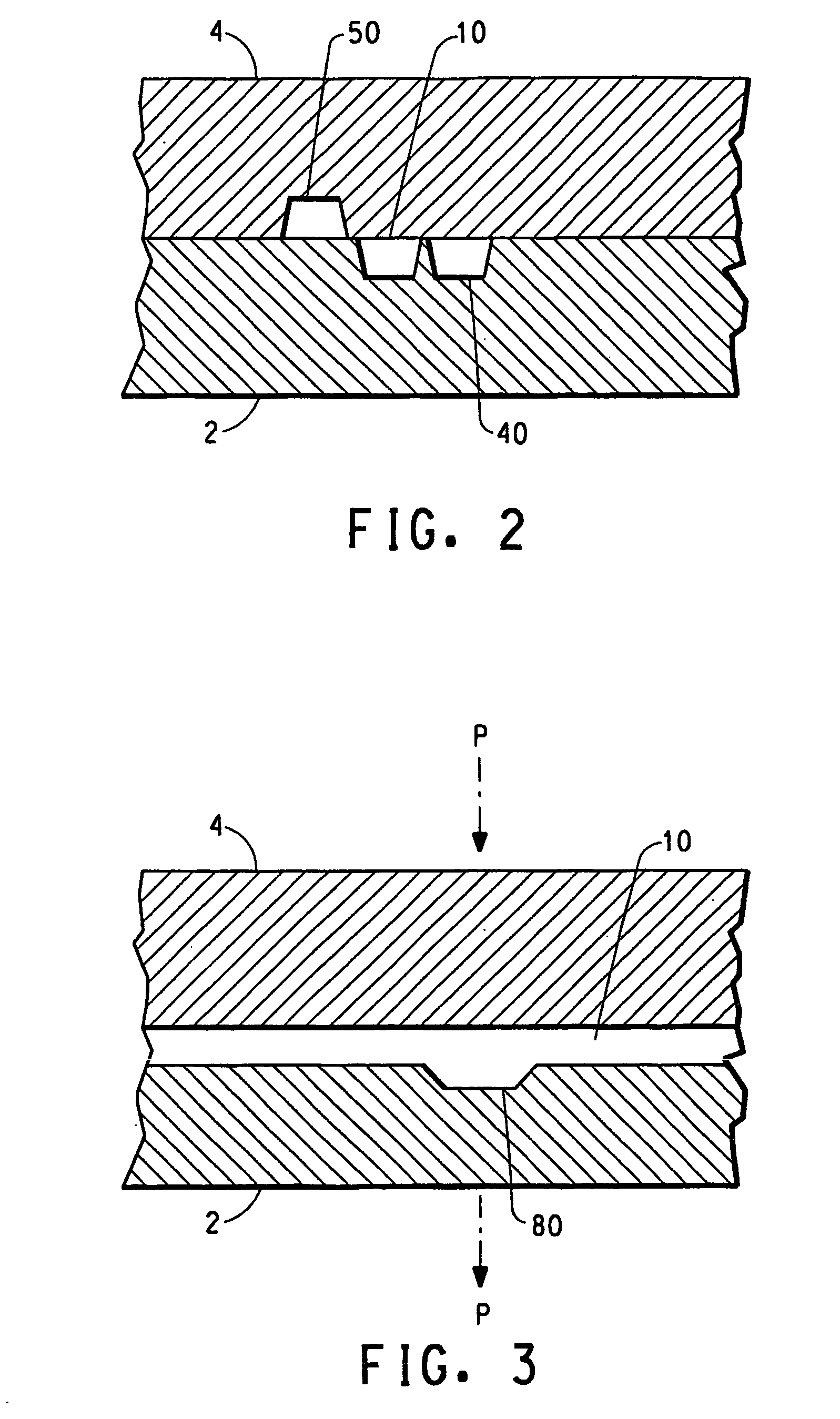Polymeric microfabricated fluidic device suitable for ultraviolet detection
a microfabricated fluid and polymer technology, applied in the field of polymer microfabricated fluidic devices suitable for ultraviolet detection, can solve the problems of inability to disclose injection molding at dimensions less than 100 .mu.m, and the limitations of silicon for this application, and each of these polymers suffers disadvantages
- Summary
- Abstract
- Description
- Claims
- Application Information
AI Technical Summary
Problems solved by technology
Method used
Image
Examples
example 1
[0041] A three-inch diameter silicon negative master mold insert was fabricated using well-known procedures in the art. This silicon master had 3 separate microfluidic devices on the wafer. Each microfluidic device consisted of a 100-.mu.m wide separation channel and two T-injection junctions. The injection channel was 50 .mu.m wide at the end joining the injection well, and it narrowed down to 20 .mu.m at the junction with the separation channel. This mold insert was attached onto the mold in the injection mold cavity with a double-sided adhesive tape. The injection molder was the horizontal type where the mold is positioned vertically with respect to the motion of the chuck holding the nozzle of the injection molder. In a vertical injection molder, the double-sided tape would not be needed.
[0042] The surface of the mold cavity was heated to about 60.degree. C. Topas.RTM. 8007 pellets were outgassed overnight in a vacuum oven at a temperature no greater than 50.degree. C. The resin...
example 2
[0048] A nickel mold was fabricated by electroplating a silicon positive having the microfabricated features with nickel. The resulted nickel mold was placed on the lower plate of a press. A .about.2.5" diameter circular hole was cut out from a 0.004" thick Kapton.RTM. polyimide film. The resulted circular space was placed on the nickel mold so that the microfabricated features on the nickel mold were contained inside the circular space. The temperature of the press was maintained at about 230.degree. C. Teflon AF.RTM. granules were placed inside the circular space to slightly over-fill the circular space. Another sheet of Kapton.RTM. was placed onto the surface of the Teflon AF.RTM. granules. A copper disk slightly larger than the circle was placed on the Kapton.RTM. sheet. The press was closed and the pressure was was applied gradually over a few minutes and the pressure was maintained at 1500 psi for 5-6 minutes. The resulting film of Teflon AF.RTM. was optically very clear and t...
example 3
[0050] A device made of polydimethylsiloxane (PDMS) was cast containing a 100 micrometer wide separation channel with a section of the channel, called a "bubble", having a vertical dimension of 200 microns. The PDMS device was bonded to a quartz plate with built-in platinum electrodes for use as an electrophoresis device. A supply reservoir was connected to one end and a waste reservoir was connected to the other end of the separation channel. The bubble was aligned with a 200 micron long by 100 micron wide optical detection slit. A standard solution of 400 micromolar para-hydroxycinnamic acid in methanol was injected into the 100 micron-width separation channel filled with a pH 9.3 aqueous borate buffer through a 50 micron-wide cross channel in the T-injection junction, similar to FIG. 1. A potential difference of 3.5 kV was applied between the electrodes in contact with the supply reservoir filled with a pH 9.3 aqueous borate buffer, and in contact with the waste reservoir. Ultrav...
PUM
| Property | Measurement | Unit |
|---|---|---|
| wavelength range | aaaaa | aaaaa |
| wavelength range | aaaaa | aaaaa |
| wavelength range | aaaaa | aaaaa |
Abstract
Description
Claims
Application Information
 Login to View More
Login to View More - R&D
- Intellectual Property
- Life Sciences
- Materials
- Tech Scout
- Unparalleled Data Quality
- Higher Quality Content
- 60% Fewer Hallucinations
Browse by: Latest US Patents, China's latest patents, Technical Efficacy Thesaurus, Application Domain, Technology Topic, Popular Technical Reports.
© 2025 PatSnap. All rights reserved.Legal|Privacy policy|Modern Slavery Act Transparency Statement|Sitemap|About US| Contact US: help@patsnap.com



